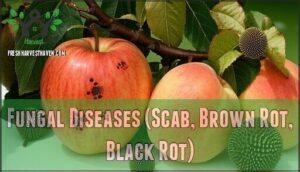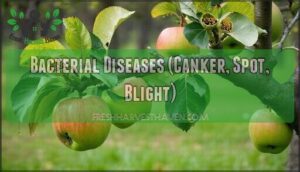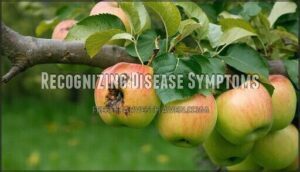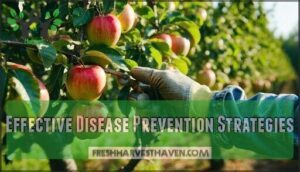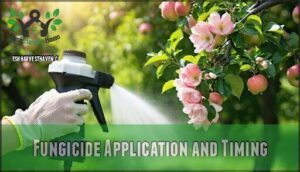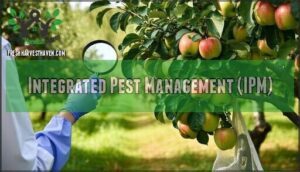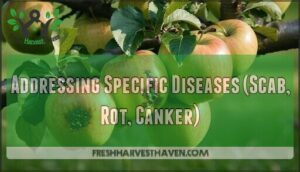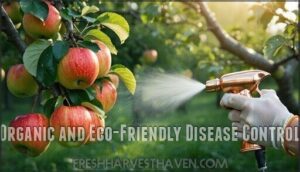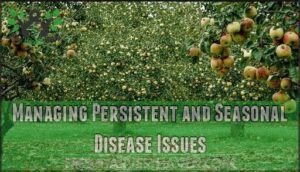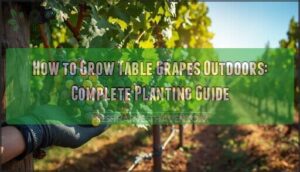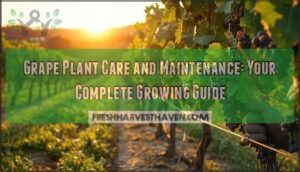This site is supported by our readers. We may earn a commission, at no cost to you, if you purchase through links.
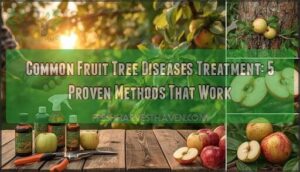 You can tackle common fruit tree diseases by first spotting the warning signs like dark spots on leaves, wilting branches, or rotting fruit.
You can tackle common fruit tree diseases by first spotting the warning signs like dark spots on leaves, wilting branches, or rotting fruit.
Apply copper-based fungicides for bacterial infections and sulfur sprays for fungal problems like scab and brown rot. Time your treatments early in the season, removing infected plant material immediately to stop spread.
Choose disease-resistant varieties when possible, and maintain proper pruning practices for good air circulation. For organic options, try neem oil or baking soda sprays that create conditions fungi can’t tolerate.
The secret lies in understanding which treatment matches your specific disease problem.
Table Of Contents
Key Takeaways
- You’ll prevent most diseases by choosing resistant varieties and maintaining proper pruning practices that improve airflow around your trees.
- You should apply copper-based fungicides for bacterial infections and sulfur sprays for fungal problems like scab and brown rot, timing treatments early in the season.
- You can use organic methods like neem oil or baking soda sprays that create conditions fungi can’t tolerate while protecting beneficial insects.
- You must remove infected plant material immediately and sterilize pruning tools between cuts to stop diseases from spreading throughout your orchard.
Identifying Common Fruit Tree Diseases
You’ll spot common fruit tree diseases by looking for specific symptoms like dark spots on leaves, rotting fruit, and unusual growths on branches.
Learning to identify these early warning signs helps you catch problems before they spread and damage your entire harvest.
Fungal Diseases (Scab, Brown Rot, Black Rot)
You’ll recognize fungal diseases by their telltale signs on your fruit trees. These common culprits spread through spores and thrive in humid conditions, making proper identification vital for effective fungal disease control.
Here’s what to watch for:
- Scab creates olive-green spots on leaves and black, scab-like lesions on fruit surfaces
- Brown rot attacks stone fruits with fuzzy gray spores and causes blossoms to wither
- Black rot forms target-like leaf spots and dark, sunken areas on apples and pears
- Fungal lifecycle patterns help determine ideal spray timing for maximum effectiveness
Understanding scab resistance levels in your varieties aids in brown rot control and black rot ID strategies.
Bacterial Diseases (Canker, Spot, Blight)
Bacterial diseases sneak up on your fruit trees like unwelcome guests. Bacterial Canker creates sunken lesions on bark, while Bacterial Spot leaves dark, angular marks on leaves and fruit.
Blight management starts with spot identification—look for water-soaked areas that turn brown quickly. These diseases spread through wounds and wet conditions.
Antibiotic treatments like streptomycin help control outbreaks, but resistance development concerns many growers. Remove infected branches immediately to prevent bacterial disease control from becoming overwhelming.
Viral Diseases Affecting Fruit Trees
Viral diseases affecting fruit trees pose unique challenges because they create systemic infections that spread throughout the entire tree. Viruses are mostly transmitted by vegetative propagation, grafting, and are vectored by mealybugs, soft scales, aphids, mites, or thrips.
Three key management approaches for viral tree fruit diseases include:
- Virus Identification through professional testing
- Vector Control targeting aphids and other carriers
- Resistance Breeding using certified virus-free stock
Management requires using only virus-free certified planting material since there’s no cure once infection occurs. Clonal propagation contributes to the accumulation of viruses in fruit trees.
Recognizing Disease Symptoms
When looking for signs of trouble, watch for leaf discoloration that appears as yellow, brown, or black spots. Wilting leaves often signal disease, especially when combined with visible cankers on bark.
Fruit rotting before harvest and unusual growths on branches are clear red flags. These symptoms of disease help you identify fruit tree diseases early, preventing plant diseases from spreading throughout your orchard.
Effective Disease Prevention Strategies
You can’t prevent what you can’t predict, but smart prevention strategies stop most fruit tree diseases before they start.
Choose disease-resistant varieties, maintain proper pruning practices, monitor trees regularly, and remove infected plant material to create a healthy orchard environment.
Choosing Disease-Resistant Varieties
Picking disease-resistant varieties is the backbone of disease management for fruit trees. You’ll want to factor in local climate and disease pressure, aiming to boost long-term health with each tree you plant. Remember that resistance is rarely complete, and some symptoms may still develop.
Pay attention to these proven strategies:
- Prioritize resistant varieties
- Use rootstock with documented resistance
- Check local extension lists
- Mix types for better overall disease prevention
Proper Pruning and Orchard Sanitation
Smart pruning techniques and tool sanitation create your first line of defense against disease spread. Prune infected branches during dry weather, sterilizing tools between cuts with rubbing alcohol. Remove all debris from around trees, as fallen leaves harbor pathogens.
Proper airflow improvement and sunlight penetration through strategic pruning strengthens your orchard sanitation efforts and aids effective disease prevention.
Monitoring and Early Detection
Regular Visual Tree Inspection helps you catch symptoms of disease before they spread. Check leaves, bark, and fruit weekly during the growing season. Environmental Risk Factors like humidity and temperature changes increase disease risk.
Keep Accurate Record Keeping of what you find and when. Use Diagnostic Sampling Methods to identify specific problems. Natural fertilizers can provide targeted nutrition.
Disease Progression Tracking lets you see patterns over time, making disease prevention and Integrated pest management more effective.
Removing Infected Plant Material
Once you spot disease symptoms, act fast by removing infected plant material. Sanitation importance can’t be overstated in disease management. Use sterilized pruning techniques to cut diseased branches, leaves, and fruit. Clean your tools between cuts to prevent spreading pathogens. Proper disposal methods and wound treatment complete your fruit tree diseases defense strategy.
- Sterilize pruning tools with 70% alcohol between cuts to prevent bacterial disease control spread
- Remove fallen leaves and rotting fruit immediately from around tree base for fungal disease control
- Burn or bag infected material – never compost diseased plant parts for effective disease control
Treatment Options for Fungal and Bacterial Diseases
When you spot fungal or bacterial diseases on your fruit trees, you’ll need targeted treatments that match the specific pathogen causing the problem.
Fungicides containing copper or sulfur work well for most fungal infections, while bacterial diseases often require copper-based sprays applied at the right time in the growing season.
Fungicide Application and Timing
Timing your fungicide applications correctly can make or break your disease control efforts. Apply protectant fungicides like captan every 7-14 days starting at bud swell, while systemic options like myclobutanil offer longer intervals but need precise timing.
| Fungicide Type | Application Timing | Spray Interval |
|---|---|---|
| Protectant (Captan) | Bud swell to petal fall | 7-14 days |
| Systemic (Myclobutanil) | Pre-infection periods | 14-21 days |
| Broad-spectrum (Mancozeb) | Green tip through season | 10-14 days |
| Copper-based | Dormant to early season | As needed |
Weather impacts everything—rain washes away protection, so reapply after heavy downpours. To manage common issues like apple scab, early detection is vital. Rotate different fungicide types to prevent resistance management issues. Your spray timing and coverage techniques determine success more than the product itself.
Copper and Sulfur-Based Sprays
Copper and sulfur are your go-to weapons against stubborn fungal diseases, as they effectively break down fungal cell walls. Bonide Copper Fungicide is best applied during dormant seasons to combat bacterial canker, while sulfur-based sprays are ideal for cool weather conditions.
Carefully follow spray timing guidelines, as copper can burn leaves in hot weather. To prevent resistance management issues and protect beneficial insects, rotate between copper and sulfur fungicides.
For more detailed information, visit copper fungicide applications.
Integrated Pest Management (IPM)
IPM combines multiple disease control methods into one smart approach. You’ll use biological controls alongside chemical protection when needed. This strategy focuses on economic thresholds—treating only when damage costs more than treatment. Monitoring techniques help you spot problems early, while resistant varieties form your foundation.
- Monitor regularly – Check trees weekly during the growing season for early disease detection
- Use biological controls first – Beneficial insects and natural predators reduce pest populations naturally
- Apply treatments at thresholds – Spray only when pest levels justify the cost and effort
- Combine multiple tactics – Mix cultural practices, resistant varieties, and targeted chemicals for best results
- Track what works – Keep records of treatments and outcomes to improve future management decisions
Addressing Specific Diseases (Scab, Rot, Canker)
When tackling specific fungal fruit tree diseases, you need targeted strategies for each problem. Apple Scab requires protectant fungicides from bud break through petal fall for scab resistance. Brown rot prevention means removing mummified fruits and strategic pre-harvest sprays. Canker treatment involves surgical removal with clean cuts four inches below infected areas.
Disease identification helps choose between organic solutions and conventional treatments for effective fungal fruit tree diseases management.
Organic and Eco-Friendly Disease Control
You can protect your fruit trees using organic methods that meet USDA standards and won’t harm beneficial insects or soil health.
These eco-friendly treatments include sulfur-based sprays, copper fungicides, and cultural practices that prevent diseases naturally without synthetic chemicals.
USDA Organic Certified Treatments
You’ll find peace of mind knowing USDA Organic certification ensures your fruit trees get only approved treatments. OMRI-listed organic solutions like Bonide Copper Fungicide and sulfur-based sprays protect your organic fruit trees while supporting soil health impact.
These sustainable orchard practices focus on pest resistance and organic disease control without compromising certification benefits. You can easily find this fungicide for sale.
Organic Sprays and Home Remedies
Through careful selection of homemade solutions, you’ll discover DIY Disease Control methods that rival commercial products. Baking Soda Sprays create alkaline conditions fungi hate, while Neem Oil Uses include disrupting pest lifecycles. Compost Tea provides beneficial microorganisms that outcompete pathogens. Companion Planting with marigolds and garlic naturally repels disease vectors.
These OMRI-listed organic solutions protect your organic fruit trees effectively. Consider using specialized fruit sprays for enhanced protection.
Cultural Practices for Organic Orchards
Building healthy organic orchards requires consistent cultural practices. Your focus on soil health, water management, and natural fertilizers creates the foundation for disease-resistant fruit trees.
Key cultural practices include:
- Soil Health: Use OMRI-listed organic solutions and compost to maintain nutrient-rich soil
- Water Management: Install drip irrigation to prevent leaf moisture that encourages disease
- Companion Planting: Plant beneficial herbs and flowers to support biodiversity and natural pest control
- Natural Fertilizers: Apply organic amendments during dormant seasons for ideal tree health
Preventing Disease in Wet Spring Conditions
Cool, wet spring weather creates perfect conditions for fungal diseases to thrive. You’ll need a proactive approach using springtime fungicides and moisture control strategies. Focus on airflow importance through proper pruning, early detection methods, and resistant rootstocks selection.
| Prevention Strategy | Implementation |
|---|---|
| Fungicide Spray Schedule | Apply OMRI-listed organic solutions every 10-14 days |
| Moisture Control | Improve drainage, avoid overhead watering |
| Airflow Improvement | Prune for open canopy structure |
| Early Detection | Weekly inspections for disease symptoms |
| Resistant Varieties | Choose cultivars suited for wet conditions |
Managing Persistent and Seasonal Disease Issues
You’ll face diseases that return season after season, requiring systematic monitoring and targeted treatment plans. Persistent issues like crown rot and recurring leaf spot need consistent management strategies that address both immediate symptoms and long-term tree health.
Dealing With Recurrent Problems (Leaf Spot, Rot)
Three stubborn enemies keep coming back: leaf spots, fruit rot, and resistant strains. You’ll need spray rotation to outsmart these fungal diseases.
Apply systemic solutions during dormant treatments when trees can’t fight back. Focus on soil health improvements and targeted fungal disease treatment. This systematic approach breaks the cycle of persistent problems.
Addressing Root and Crown Diseases
Root and crown diseases attack your tree’s foundation, literally. Phytophthora is the main culprit, thriving in wet, poorly drained soils. You’ll spot darkened bark at the trunk base and stunted growth above. Crown gall creates rough, tumor-like growths.
Prevention beats treatment every time. Plant on well-drained sites, choose resistant rootstocks, and avoid overwatering. Early copper sprays help, but proper drainage is your best defense.
When to Consult Local Horticultural Extension
Contact your local county horticultural extension when symptoms of disease persist despite treatment efforts. Extension experts provide disease identification help, treatment plan advice, and local pest alerts specific to your region.
They understand regional growing conditions and offer soil testing insights. These specialists excel at fruit tree management and disease control tactics that work in your area’s climate and soil conditions.
Maintaining Tree Health Year-Round
Beyond professional help, consistent monitoring keeps your fruit trees healthy year-round. Seasonal tree care responds to dormant season needs and active growth periods. Long-term health requires systematic disease management tactics. Consistent pruning helps prevent black knot identification.
- Winter dormancy: Apply dormant sprays and prune for airflow
- Spring monitoring: Watch for early disease signs during wet conditions
- Summer maintenance: Continue chemical protection and remove infected material
Frequently Asked Questions (FAQs)
Can diseased fruit trees infect neighboring plants?
Ever wondered if disease spreads like neighborhood gossip? Diseased fruit trees can absolutely infect neighboring plants through airborne spores, insects, wind, and contaminated tools, making early detection and removal essential.
How long do fungicide treatments remain effective?
Fungicide treatments usually last 7-14 days, depending on weather conditions. You’ll need to reapply after rain or when new growth appears. Always check the product label for specific timing recommendations.
What causes fruit tree diseases to recur?
You’ll see diseases return when infected plant debris stays around, environmental conditions favor pathogens, you skip preventive treatments, or plant susceptible varieties without resistance genes.
Are chemical treatments safe for edible fruit?
Can you balance safety and efficacy? Chemical treatments can be used on fruit trees up to four times during the growing season, following strict label directions.
You’ll need proper timing to avoid bloom periods, ensuring both effective protection and edible fruit safety.
Do weather conditions affect disease treatment success?
Yes, weather substantially impacts treatment success. Rain washes away fungicides before they dry, while high humidity promotes fungal growth. Apply treatments during dry periods with moderate temperatures for best results.
Conclusion
Mastering common fruit tree diseases treatment transforms your orchard from a disease battlefield into a thriving paradise. You’ve learned five proven methods that work consistently.
Apply these evidence-based strategies systematically, and you’ll see dramatic results. Remember, timing matters most with fungicide applications and pruning practices. Don’t wait until symptoms worsen.
Start implementing these common fruit tree diseases treatment protocols today, and watch your trees flourish with healthier fruit production.

